#antonio pigafetta
Text


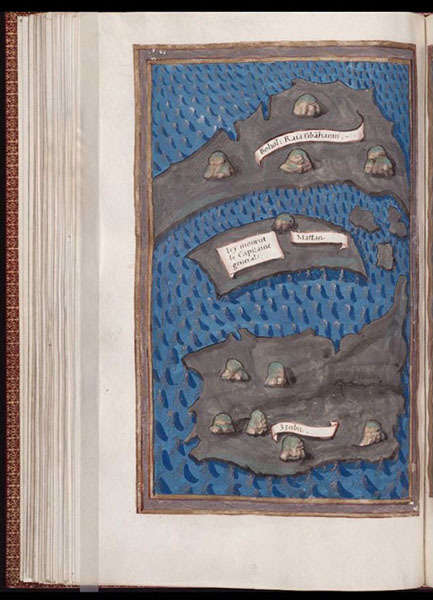


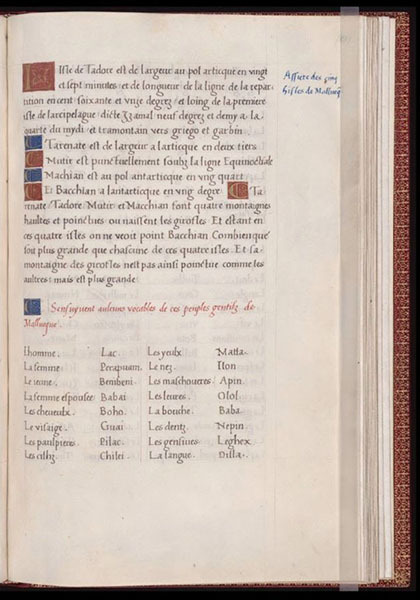

Antonio Pigafetta – Scientist of the Day
Antonio Pigafetta, a Ventetian writer and adventurer, set sail on Sep. 20, 1519, on board the Trinidad, on what would turn out to be the first circumnavigation of the globe.
read more...
#Antonio Pigafetta#voyages#Magellan#histsci#histSTM#16th century#history of science#Ashworth#Scientist of the Day
57 notes
·
View notes
Text
the following is an excerpt from The First Voyage Round the World / Pigafetta's Account of Magellan's Voyage - Antonio Pigafetta, chronicler of Magellan's voyage to circumnavigate the globe, translated by Lord Stanley of Alderley
To explain the kind of fruits above-named it must be known that the one which they call cochi, is the fruit which the palm trees bear. And as we have bread, wine, oil, and vinegar, proceeding from different kinds, so these people have those things proceeding from these palm trees only. It must be said that wine proceeds from the said palm trees in the following manner. They make a hole at the summit of the tree as far as its heart, which is named palmito, from which a liquor comes out in drops down the tree, like white must, which is sweet, but with somewhat of bitter. They have canes as thick as the leg, in which they draw off this liquor, and they fasten them to the tree from the evening till next morning, and from the morning to the evening, because this liquor comes little by little. This palm produces a fruit named cocho, which is as large as the head, or thereabouts: its first husk is green, and two fingers in thickness, in it they find certain threads, with which they make the cords for fastening their boats. Under this husk there is another very hard, and thicker than that of a walnut. They burn this second rind, and make with it a powder which is useful to them. Under this rind there is a white marrow of a finger's thickness, which they eat fresh with meat and fish, as we do bread, and it has the taste of an almond, and if anyone dried it he might make bread of it. From the middle of this marrow there comes out a clear sweet water, and very cordial, which, when it has rested a little, and settled, congeals and becomes like an apple. When they wish to make oil they take this fruit, the coco, and let it get rotten, and they corrupt this marrow in the water, then they boil it, and it becomes oil in the manner of butter. When they want to make vinegar, they let the water in the cocoa-nut get bad, and they put it in the sun, when it turns to vinegar like white wine. From this fruit milk also can be made, as we experienced, for we scraped this marrow and then put it with its water, and passed it through a cloth, and thus it was milk like that of goats. This kind of palm tree is like the date-palm, but not so rugged. Two of these trees can maintain a family of ten persons: but they do not draw wine as above-mentioned always from one tree, but draw from one for eight days, and from the other as long. For if they did not, otherwise the trees would dry up. In this manner they last a hundred years.
imagine crossing the pacific ocean without knowing what a coconut is, they had to learn about it on the other end of the journey. Also, I love the fact that one of the first things that my people talked about with these strangers was this plant, which goes to show how much we loved these fruits even then. Can confirm, we are still obsessed with coconuts until now.
12 notes
·
View notes
Text
//I will say this, though: By the time I finish [Atz’lut v Ta’avah], with [Ira et Avaritia] done, I can actually start writing up the four’s experiences in the Magellan Expedition, what happened to them in the Battle of Mactan, and how they sold their souls to the Master.
And from there, we can learn what the Four did during the 50 years in Sugbu, and the arrival of St. Emilio, who was responsible for gouging out the Devil’s Eye, setting up the events of the main story.
#[OOC]#I'll give '1521' a shot tho#like#begrudgingly#if at least to see how they did their fashion and sets#and how close they followed Antonio Pigafetta's journal#they BETTER FUCKING GODDAMN write this story from the Filipinos' perspective#even if the story follows the Expedition predominantly#no more of this 'it's a good thing the Spanish came' BULLSHIT
2 notes
·
View notes
Text
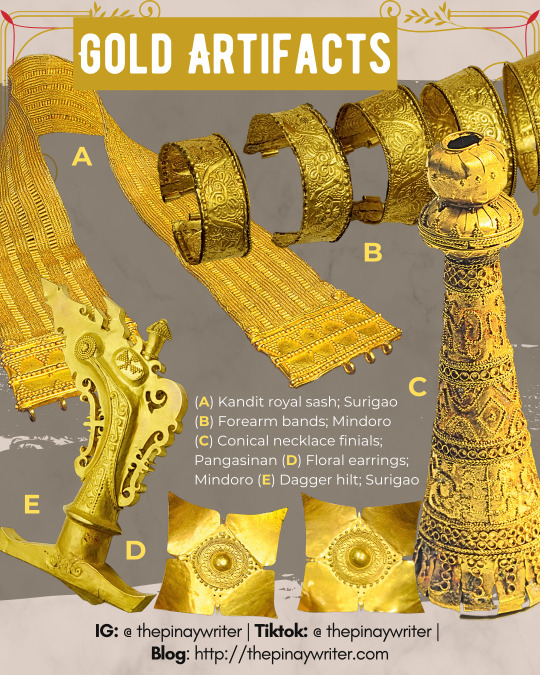

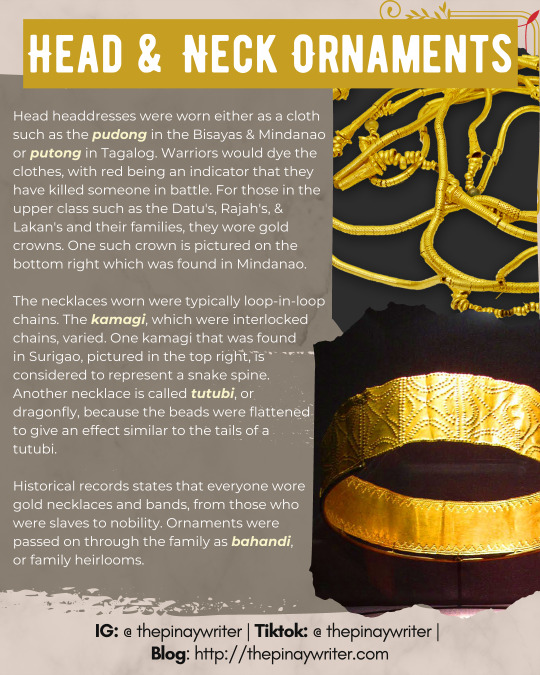
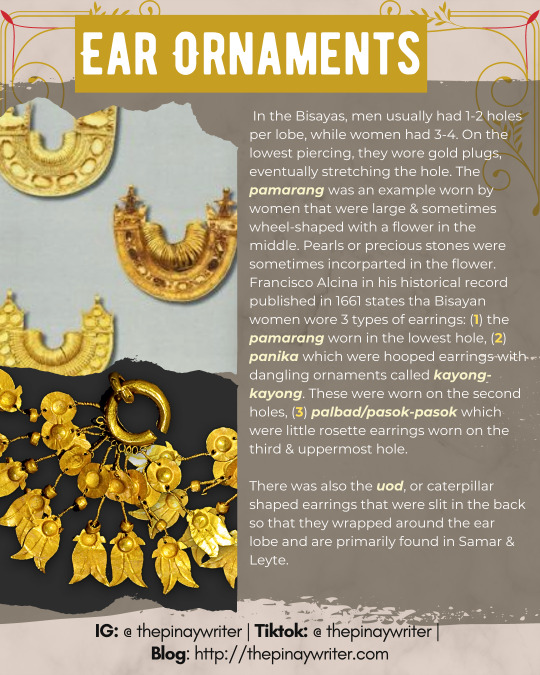

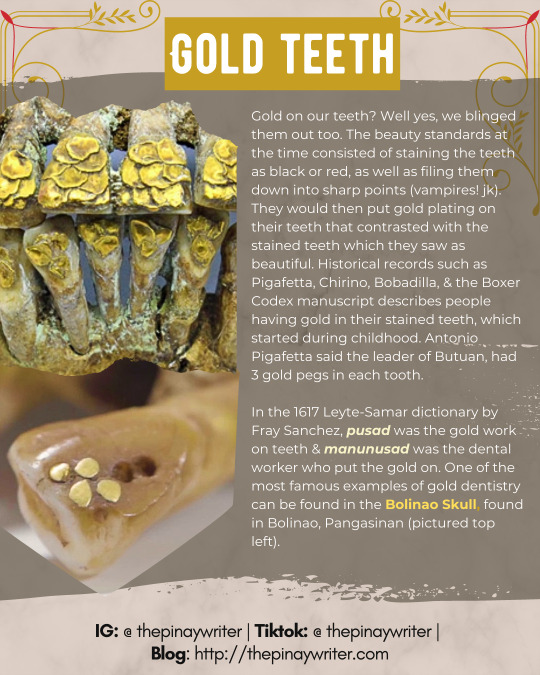


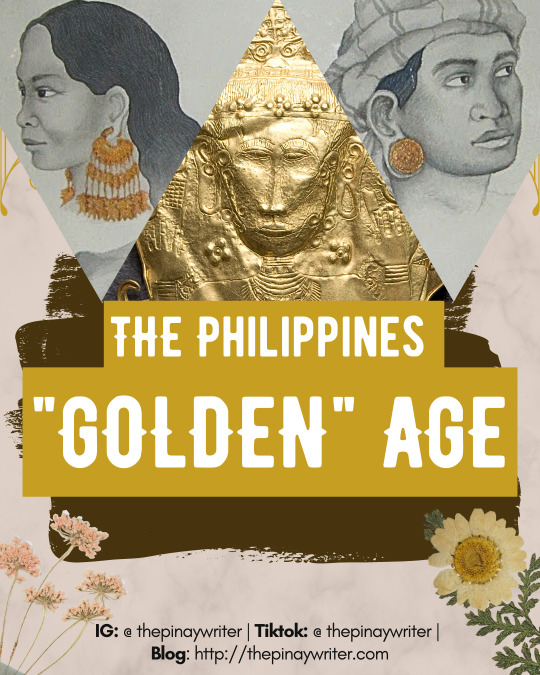
✨️ Our ancestors before the Spaniards arrived wore gold and passed them down through the generations, regardless of social class. They even crafted bowls, liquid vessels, and the hilts and covers of daggers and swords out of gold.
They buried these ornaments with the dead so that they could use it in the afterlife and as a token to give the spirit or deity to leave purgatory. They also covered the faces of the dead with gold death masks to protect them from evil spirits entering the body.
Numerous Spanish accounts record that they wore gold and buried their dead with gold bahandi, or heirlooms. From Antonio Pigafetta, Francisco Alcina, Pedro Chirino, Friar Bobadilla and within the Boxer Codex Manuscript. Together with historical accounts, archeological finds of gold artifacts from Luzon, the Bisayas, and Mindanao show how much our pre-colonial ancestors wore and used gold in their clothing, divine figures, and everyday wear, similar to the rest of Southeast Asia.
To see many of these artifacts, check out the gold exhibit in the National Museum of the Philippines and Ayala Museum.
#filipino#philippines#precolonial Philippines#gold#artifact#history#culture#filipino culture#pinoy#filipino mythology#archaeology
907 notes
·
View notes
Note
hi ame!! just remembered you planned on being a historian and was curious if you had a top five Philippine history books you recommend people to read. i really need to brush up on my fil lit, and i thought this was the best place to ask haha
omg ok so. i have many history books BUT i have not read any of them yet bc of time constraints, BUT i will try my best to recommend some based on what i've heard/what i've skimmed. also sorry this exceeded 5 HAHAHAHA
rizal without the overcoat by ambeth ocampo - a comprehensive analysis of rizal. not to out myself but i gained the privilege to have ambeth ocampo as my history prof last schoolyear, and his explanation for the title is very intriguing? because overcoats aren't generally worn in the philippines, they're worn in european places that are cold. so removing the overcoat from rizal attempts to view him deeper within philippine contexts.
and on that note, ANYTHING by ambeth ocampo! he has a cheap book series about ph history called "looking back" that have many topics and variations. each book is just 150 pesos and i hoarded all of them when i saw it sa nbs HAHA
some are smarter than others by ricardo manapat - a book about the marcos' "crony capitalism". if you check the cover, it looks like a xeroxed document, and it's because it is! the book itself began during martial law and it recounts all of marcos' expenses and capitalistic faults. this means you're reading directly from people who were experiencing martial law in real time. i skimmed through the pages of it and there are actual like. lists of all of the shit the marcoses bought + its prices alongside comprehensive information about it.
a question of heroes by nick joaquin - this is like the history bible for your luzon-based national heroes. i have not read it but it's supposed to critique how contemporary filipinos view heroes, so go give it a read!
barangay by william henry scott - it's a big bummer that a lot of records on indigenous filipino culture were written by our colonizers, but still, give this a read if you want comprehensive descriptions on the indigenous period!
^ and on that note, go read the journal of magellan's voyage by antonio pigafetta. you don't need to read all of it, but read the portions about their experiences with filipinos (march 16 1521 onwards)
the philippine revolution by apolinario mabini - THE WEBSITE OF THIS GOT DELETED UGH but if you manage to find a copy, it covers his exile by the americans onwards, and it was a pretty interesting read!
^ and on the topic of books written by filipino historical figures, READ ALL OF THEM! LIKE, ALL OF THEM! DIRECT SOURCES! aguinaldo has a book, gregoria de jesus had letters, rizal had letters- all that! good shit!
and i mean. read your noli and fili that one's self-explanatory KJGLGKJ. dekada '70 too! my brother read it and he enjoyed it so i trust him
and i'm gonna end on a special gold mine. the philippine islands by blair & robertson is an interesting index filled with western research/records of idigenous filipino culture. disclaimer, a LOT of it is biased, but my god there is a lot of resources to look up on. check volume 54-55 for a table of contents, then work your way from there!
big tip for searching on your own- you won't get far googling stuff because a lot of these aren't easily searchable. the most it can give you, which is helpful, are comprehensive lists of history books written by filipino historical figures. but, if you want good shit, PLEASE GO TO NBS/FULLY BOOKED!! GO TO THE HISTORY SECTION!! even if you can't buy them, you can google pdf's of the title (hopefully) or you can go to any nearby library if you have one!!
76 notes
·
View notes
Text
Dr. Bene ft Nosecuenta - Defensores del Mar del Sur.
Mantoi:
! Ayayai! , esta estrofa es mia,
En ella hay tension y armonia,
Cachai? Si, yeah
Como en un hokusai
importa la parte vacia,
Viste el mapa al revez
Emece anota,
Americano es lo que te dicen en europa
Es mas bien no saber tu propia,
identidad tener esa y tambien la otra,
Una mescolanza es lo que somos
en verdad pura,
solo es la esperanza de poder vivir en paz,
Ahora,
Se bienvenido al sur poeta,
Nosecuenta Mente Sabia crü
no cave en tu maleta,
Porque el mundo NO es lo que TU
cantas en tus letras,
Vengo a mostrar su amplitud
como Antonio Pigafetta.
#msc#mente sabia cru#mentesabiaasesina#mentesabia#dr.bene#nosecuenta#mantoi#rap#rap chileno#chile#urbano#defensor#Sur#surdechile#musicachilena#rapper#referentes#Arte#Artemusical#my music#Beat#djperez#Perez#Perezmuerez#Muerez#Criminalbeat#bronkoyotte#bronko#Mar#Mardechile
2 notes
·
View notes
Text
If you live anywhere South of 15 degrees North latitude and step outside on a moonless night in a location without any light pollution in December or January, you will see two wispy “clouds” in the South, preceding the Milky Way as it rises in the East.
These are not clouds, of course but galaxies- systems of stars and gas and dust held together by gravity just like our own galaxy, the Milky Way is. They are known as the Large and Small Magellanic Cloud respectively, and while not the closest galaxies to us ( there are some “ dwarf” galaxies much closer to us), they are the closest large galaxies and certainly the only two that are so easily visible to the naked eye.
The “ clouds” have been known to humans for thousands of years.Every indigenous Australian group has mention of the clouds in their oral tradition. For example, the Yaraldi people tell a story about two cranes who, knowing that the emus would hunt them and kill them, flew up into the air, circling around, higher and higher, until they reached the sky. They found it to be a good country to live in, so they stopped there. You can see them in the heavens at night, "in the form of two patches of clouds, like wisps of smoke, at the end of the Milky Way."
Similarly, the Tupi-Guaranis, in the region of Rio de Janeiro in Brazil, compare the Clouds to fountains where a tapir (in the LMC) or a pig (in the SMC) is drinking. The Mapuche in Chile also compare the Clouds to water ponds, called Rüganko or Menoko in their language.
The clouds were also well known to the Arabs and Chinese and to anyone who sailed the southern seas, including Western explorers, especially the Portuguese, and most certainly Amerigo Vespucci who mentioned them in his writings in 1504.
So why are they named after Magellan? I can’t really find the answer. Antonio Pigafetta - who joined Magellan’s expedition - mainly to become famous, with no assigned role - wrote an account describing the clouds on or around 28 November 1520, and his account of Magellans voyage became quite famous; but of course neither he nor Magellan had the hubris to name the clouds after the explorer!
In fact the clouds were known as Nubecula Minor and Nubecula Major for a long time, especially in the scientific literature. However somehow nautical circles had been using the name Magellanic Clouds; and slowly as the usage of Latin names dwindled , the popular name seems to have taken over… till in 1847 John Herschel used the popular name for the first time in a scientific publication.
But as our old friend, Bill Shakespeare wrote “ what’s in a name”?
The clouds are wonderful objects for professional and amateurs alike to explore; which I enjoy doing; and so I chose the Large Magellanic Cloud as the target for my last image for 2022.
2 notes
·
View notes
Text
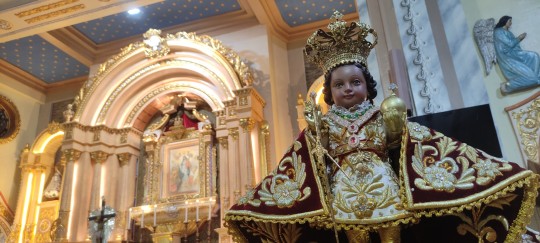
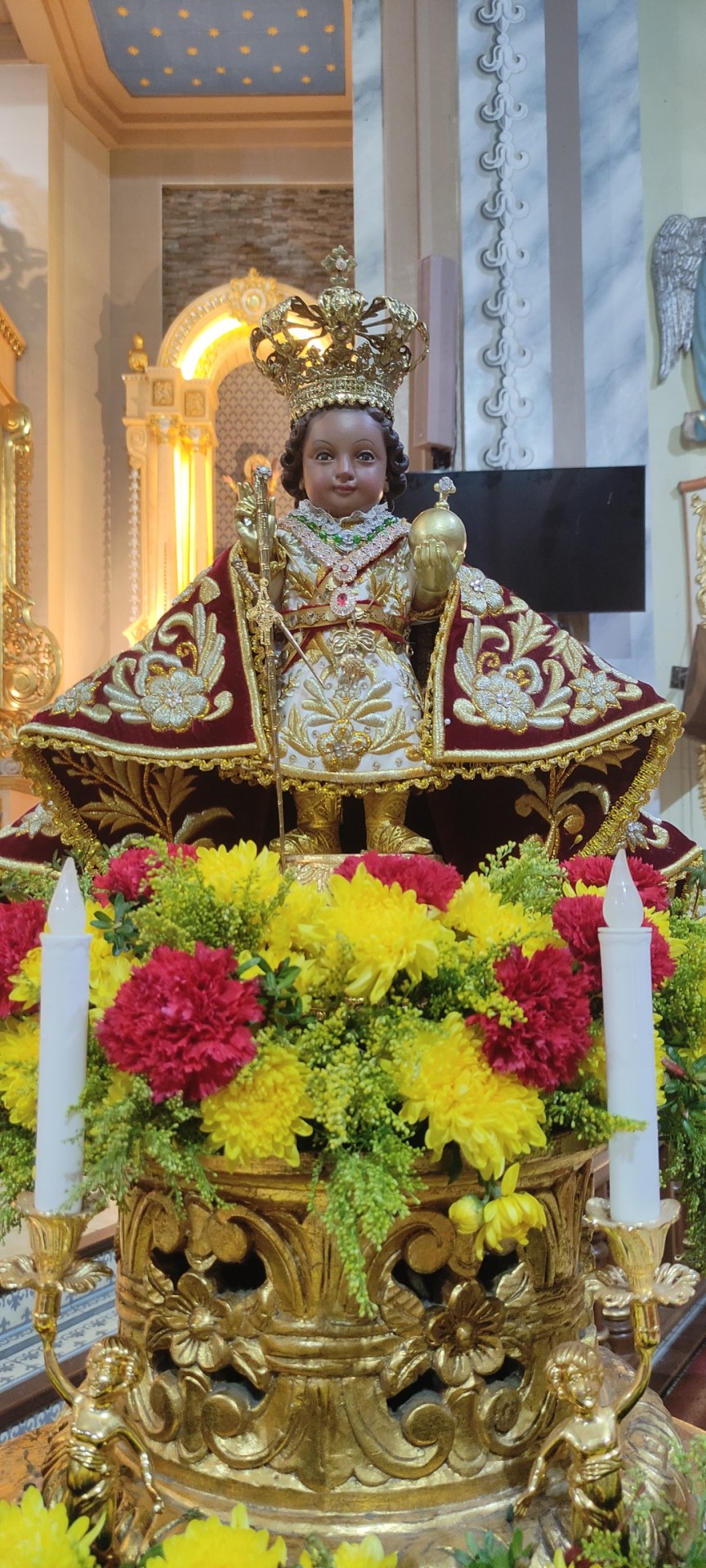

THE DESCRIPTION OF THE SANTO NIÑO (Sto. Niño)
The Ultimate Crown Jewel of Filipino Devotion
Feast Day: Third Sunday of January
Pit Señor! The feast of the Santo Niño is celebrated every year on the third Sunday of January.
On April 14, 1521, the image of the Holy Child was presented to the wife of Rajah Humabon (later named Don Carlos), Hara Humamay (later named Queen Juana of Cebu) by Ferdinand Magellan after her baptism. On the same day, 800 Cebuanos were also baptized.
The Italian scholar and chronicler of the expedition, Antonio Pigafetta wrote: 'After dinner, Fr. Pedro Valderrama (the fleet chaplain) and some others went ashore to baptize the queen. We conducted her to the platform and she was made to sit on a cushion. I showed her an image of Our Lady, a very beautiful wooden Child Jesus and a cross. After her baptism, she asked us to give her the little Child Jesus to keep in place of her idols.'
After Magellan's death days later on April 27th, and the massacre of 27 other Spaniards by the Cebuanos, the survivors hurriedly embarked and continued their voyage to Spain. For more than four decades (40 years), the cross and the Santo Niño left behind by Magellan remained as silent witnesses of Jesus Christ among the Filipinos.
The Spaniards came back to the Philippines in 1565, under the command of Gen. Miguel López de Legazpi. A soldier of the expedition, Juan Camus, found the image of the Santo Niño inside the house of a native.
This was attested by Fr. Andres de Urdaneta, the Augustinian chronicler of the expedition, and many other witnesses. The image has been venerated by the Filipinos ever since, and it is preserved at the magnificent Basilica del Santo Niño (formally called Basílica Menor del Santo Niño de Cebú or Minor Basilica of the Holy Child of Cebú) in Cebu. Today, the original image is permanently encased behind bulletproof glass inside its chapel.
The wooden statue of the Child King, of the style of those made in Belgium, synthesizes the childhood and the kingship of Christ.
The King of the Universe, who became a little child, keeps telling us in the Holy Gospel according to Matthew: 'Unless you turn and become like children, you will not enter the kingdom of heaven. Whoever humbles himself like this child, is the greatest in the kingdom of heaven.'
©2024 photos by yours truly
0 notes
Text

You may have heard of the mythical, gigantic former inhabitants who wandered the wastes of Patagonia... The vision of a faraway land, inhabited by towering giants, has captured and enchanted European imaginations for many years. But was Patagonia really the home to these larger-than-life folk, or was it no more than a myth spread by fantasists...?
The first mention of the giants, supposedly twice the height of the normal human being, appeared in the Italian chronicler Antonio Pigafetta’s account of Ferdinand Magellan's travels. This official record reported that Magellan’s crew got more than they bargained for during their circumnavigation of the globe in the 1520s. Pigafetta details a dancing and leaping giant on the shores of Argentina. Not one to take all the glory for himself, Magellan selflessly sent a poor crew member over to the gallivanting giant to make contact...
The giant was reportedly very friendly, and so colossally tall that the Europeans only reached his waist. Magellan named them ‘patagones’, and many believe this to have come from the Portuguese word ‘pata’, meaning ‘foot’. The so-called giants left huge, gaping footprints in the snow because of the large guanaco-skin moccasins they wore on their feet. Patagonia may thus mean ‘land of the bigfoot’, which unsurprisingly contributed to the rumours and mythologisation of the Patagonian giants. One other suggestion, however, is that Magellan took the name from the giant Patagón, a prominent character in the sixteenth-century Spanish chivalric romance Primaleón, which Magellan had more than likely read. Spanish explorers of the day often took inspiration from a recent good read; indeed, ‘California’ came from a mythical island of the same name in another Spanish romance, Las Sergas de Esplandián). Magellan captured two of these giants to take back to Spain with him, but they sadly died on the homeward voyage.
Then a century on, in 1628, Sir Francis Drake’s nephew detailed his uncle’s circumnavigation in The World Encompassed, and mentioned once more the legendary giant-dwellers of Patagonia... Drake the nephew suggested that, though the native people were far taller than any Europeans the crew had seen, perhaps Magellan’s crew had exaggerated the size of the Patagones, thinking it unlikely that anyone would ever go back to Patagonia to check, and indulging their friends and family by spinning a good yarn...
But then in 1615, the Dutch circumnavigators Willem Schouten and Jacob Le Maire found graves containing human bones on the Patagonian shores... bones of beings which appeared to be ten or eleven feet tall...
Later on in 1766, Captain John Byron (grandfather to the poet) also circumnavigated the world and the story spread that the crew had encountered enormous, nine-foot giants. Rumors flew furiously around Europe, and the line between fact and fiction grew increasingly blurred... There were bitter disputes between French and British scientists, the former believing that the latter were supporting the case for the existence of giants as a smokescreen, hiding what the French feared most: that British sailors were not really embarking on a giant-hunt in Patagonia, but rather scoping it out as an entry point to attack French territories in the New World.
It was in 1767 that the romantic vision of Patagonia as a wilderness hiding giants started to fade. French explorer Louis de Bougainville reported that the tallest Patagonian he came across was only 5ft 9in, and then, in 1773, the official account of the Byron voyage emerged... in reality, the so-called “giants” were only four inches taller than the most sky-scraping crew members.
Personally, I believe there were Giants. I wish we lived there. The Patagonian Giants would be an awesome name for a Football team.
0 notes
Text
ĐÁ GÀ TRỰC TIẾP – ĐÁ GÀ THOMO – ĐÁ GÀ CỰA DAO MỚI NHẤT NGAY HÔM NAY
Dagatructiep360 là trang web phát sóng LIVE đá gà trực tiếp thomo tại những sòng gà nổi danh thế giới và lưu giữ tất cả các trận đá gà đỉnh cao. Chúng tôi sẽ tổng hợp và phát sóng các video xem đá gà trực tuyến và chọi gà siêu hay và hấp dẫn nhất hiện nay. Các bạn hãy theo dõi toàn bộ những trận chiến và thậm chí là đá gà Campuchia trực tiếp hoặc đá gà trực tiếp hôm nay tại trang web xem đá gà trực tiếp – Dagatructiep360 nhé.
Đá gà hay là còn có tên gọi khác là chọi gà. Đây là một thể loại hình đá gà có mặt tại đất nước Việt Nam từ rất lâu. Tuy nhiên, cội nguồn của trận đá gà chọi đã được ghi chép lần đầu vào năm 1521, trong cuộc thám hiểm Philippines của Ferdinand Magellan. Antonio Pigafetta – một chuyên gia – nhà sử học người Ý đã chép lịch sử cho Magellan, đã ghi chép lại lịch sử về sự kiện đá gà này tại Vương quốc Taytay.
Và đến thời điểm hiện nay, trò chơi đá gà trực tiếp được coi là một sở thích và cũng là “chân ái” của các anh em sư kê. Đặc biệt, tại các tỉnh thành thuộc miền Bắc và miền Nam, bộ môn này đã và đang được coi là một “đại hội” được tổ chức định kỳ mỗi dịp Tết với sự góp mặt của cả ngàn chiến kê, “thần kê”, trên khắp mọi miền đất nước.
Nguồn: Đá gà trực tiếp Thomo360
0 notes
Text
Vicenza: il nuovo parco di Bertesina intitolato a Maria Teresa Fortuna Canivet

Vicenza: il nuovo parco di Bertesina intitolato a Maria Teresa Fortuna Canivet.
Il parco di Bertesina, di fronte alla chiesa parrocchiale, è stato ufficialmente intitolato a Maria Teresa Fortuna Canivet, vicentina, archeologa illuminata e tra le fondatrici dell'International Soroptimist Club.
La cerimonia ha visto gli interventi di Isabella Sala, vicesindaca del Comune, Giovanni Selmo, assessore all'istruzione e all'edilizia scolastica, Antonietta Bacchetta, presidente Soroptimist Club Vicenza, Giovanna Guercio, presidente nazionale Soroptimist International, Giorgio Sala, ex sindaco di Vicenza e amico di Fortuna Canivet, Giuliano Bellieni, segretario generale dell'Accademia Olimpica, e Giampaolo Fortuna, fratello di Maria Teresa Fortuna Canivet. Presenti anche due classi, da 34 alunni ciascuna, della scuola primaria Gonzati dell'istituto comprensivo 2.
«Questo parco oggi si arricchisce di un elemento significativo: un nome che ha dietro di sé la vita di una donna importante - ha affermato la vicesindaca Isabella Sala -. Maria Teresa Fortuna Canivet ha vissuto nel mondo e ha portato nella sua città i suoi studi e le sue scoperte. È passata alla storia per l'importante scoperta dell'iscrizione di Ponzio Pilato a Cesarea Marittima, avvenuta nel giugno del 1961. Come scrive nel suo libro sulle grandi donne vicentine Antonio Di Lorenzo, membro anche della commissione consultiva per la toponomastica cittadina che ha indicato questa intitolazione, in tanti erano passati davanti alla lapide con la firma di Ponzio Pilato, ma nessuno aveva capito che quella rappresentava l'unica prova scientifica della sua esistenza. Ringrazio quindi tutti i presenti ed in particolare l'associazione Soroptimist, che ha voluto fortemente questo giorno, per il suo messaggio di pace e cultura di cui anche oggi si fa portavoce».
«Mi rivolgo in particolare ai bambini presenti - ha continuato l'assessore all'istruzione e all'edilizia scolastica Giovanni Selmo - per annunciare che, grazie alla generosità di Soroptimist, vi consegniamo una brochure dove potrete approfondire la storia straordinaria di questa vicentina nel testo tratto dal libro "Le grandi donne vicentine della storia" di Antonio Di Lorenzo. Vi doniamo anche un biglietto del Museo Naturalistico Archeologico per andare a vedere di persona quello che ha studiato Maria Teresa Fortuna Canivet. Il nostro museo custodisce infatti il reperto romano di terracotta Potnia theròn - Signora degli animali, che Canivet esaminò per prima».
Alla vicesindaca Isabella Sala è spettato il compito di scoprire la segnaletica con la nuova intitolazione, mentre alla presidente nazionale Soroptimist Giovanna Guercio la targa dedicata alla vicentina.
Il parco è suddiviso in più aree: l'arena verde con tre file di gradoni con sedute in legno, l'area giochi dove è inserito un bike park e il viale alberato nord-sud; i posti auto sul lato sud e lungo via San Cristoforo, l'area "quieta" con il giardino delle essenze. L'area verde è stata di recente realizzato insieme alla piazza di Bertesina, già intitolata nel 2021 a monsignor Giulio Cattin, grazie al protocollo d'intesa siglato tra Comune di Vicenza, Viacqua Spa e Sar Servizi a Rete srl nel 2019.
Biografia:
Maria Teresa Fortuna Canivet, archeologa, è nata a Vicenza il 18 agosto 1927 e morta a Parigi il 28 aprile 1982. È sepolta nel cimitero maggiore di Vicenza. Dopo la maturità classica al Liceo Pigafetta, si è laureata in Lettere all'Università di Padova dove ha avuto incarichi didattici. Con il marito professor Pierre Canivet, archeologo, ha effettuato scavi archeologici in Medio Oriente fra Iran, Siria, Palestina, Turchia. Anche a lei si deve l'eccezionale scoperta nel 1961 a Cesarea Marittima (oggi in Israele) dell'unica lapide esistente con la firma di Ponzio Pilato, "prova regina" della sua reale esistenza, documentata solo nei Vangeli. È stata socia corrispondente dell'Accademia Olimpica di Vicenza dal 1970; nel 1975 è tornata a Vicenza per una memorabile conferenza su: "L'immagine di Adamo-Cristo in una chiesa di Huarte (Siria) del secolo V". Nel 1986 l'Accademia Olimpica l'ha ricordata con un volume di suoi scritti (prefazione Mariano Rumor e Giorgio Oliva). È stata tra le prime socie e fondatrici del Soroptimist Club di Vicenza, oltre che prima presidente vicentina dell'International Soroptimist Club....
#notizie #news #breakingnews #cronaca #politica #eventi #sport #moda
Read the full article
0 notes
Text

Ferdinand Magellan’s Voyage
It is currently 1525 and the Manuscript is now present detailing Ferdinand Magellan’s voyage around the world in 1519. The work has been attributed to a scholar born in Vincenza, Italy Antonio Pigafetta, who kept a a detailed journal of the voyage. Although Pigafetta lost the original journal during his voyage with Ferdinand, he managed to save four manuscripts. One of the manuscripts is written in Italian and three others are written in French. Pigafetta's journal states that on September 20, 1519, Portuguese explorer Ferdinand Magellan set sail with five ships and 270 of his men from Sanlucar de Barramenda in southern Spain. This Vogaye was set to be his first circumnavigation of the world. At this time it appeared that there was strong competition between Spain and Portugal to dominate different parts of the world. Magellan's journey took an unexpected time frame of 3 years. During this voyage, they faced challenges such as running out of fresh food along with ships that were vanishing or being sunken due to horrible weather conditions or they simply gave up on the journey while seeing others die of frostbite or infectious diseases. Magellan’s voyage had a purpose, to demonstrate that the globe was indeed round. It is said that this voyage was not meant to be a scientific expedition rather it was a commercial and political expedition by the Spanish monarchy. During this Voyage, Pigafetta includes an early Western description of the people and language of the Philippines, where Magellan died in battle. Pigafetta also includes that of the approximately 240 men that were sent out only 18 men returned to Spain including Pigaffeta. Magellan’s voyage has been one of the most important journeys in history since it helped prove the idea that the earth was round, it expanded commerce by providing different alternatives to commerce routes, and it helped draw world maps for the foreseeable future.
0 notes
Text
PELEAS DE GALLOS


na pelea de gallos o riña de gallos es un combate que se lleva a cabo entre dos gallos de un mismo género o raza de aves denominada "aves finas de combate", propiciados por el ser humano para su disfrute y apuestas. Cabe destacar que muchas personas y organizaciones las critican por causar el daño a propósito de esos animales
Las peleas más antiguas de las que tenemos noticia ocurrían en Asia. En China ya se celebraban hace dos mil quinientos años y es posible que mil años antes se hicieran en la India. En la Antigua Roma eran usadas para adquirir valentía. Las peleas de gallos ya estaban floreciendo en la Filipinas precolonial, según lo registrado por Antonio Pigafetta, el cronista italiano a bordo de expedición de Fernando Magallanes en 1521, donde dicha práctica fue presenciada por primera vez. La práctica en dichas islas deriva del hecho de que comparten elementos de las culturas indígenas del sureste asiático y otros, donde las aves de la selva y del tipo oriental de pollo son endémicas. Posteriormente, esta práctica fue llevada a América por los españoles.
Al final del siglo XVIII, en su tratado de historia natural, Buffon nos relata varias tradiciones de peleas con gallos y otras aves.1.
Pelea de gallos[editar]
La arena, ruedo, redondel, palenque o coliseo destinado para ese fin específico se conoce como gallera, donde el ave que demuestra mejores cualidades en el combate se declara como ganadora. Para ello debe dejar a su adversario inhabilitado para seguir peleando. En algunos casos hay gallos con "poca casta" que huyen de la pelea al estar heridos en cuyo caso pierden el combate o la pelea de los gallos.
Los gallos de razas finas o de combate son criados bajo normas de vacunación, alimentación y cuidados especiales para lograr un desarrollo físico ideal y los de mejores cualidades para la riña se someten a un acondicionamiento físico o entrenamiento para llegar a su encuentro en el ruedo, cancha, coliseo, etc.
En algunas regiones, en las riñas, los gallos son equipados con espolones artificiales de plástico, carey, hueso de pescado, acero, etc. que permiten que las aves puedan herir a su oponente más fácilmente que con sus espolones naturales. En otras variaciones de riña los espolones naturales son cubiertos con una envoltura de tela o cuero para prolongar el combate. La riña sin espolones artificiales o sin envoltura en los mismos se le denomina como pelea a "talón desnudo". Otra modalidad de arma en la riña de gallos es la utilización de navajas en las patas del animal con medidas y formas variables (desde 1/4 pulgada hasta 4 pulgadas), suplantando de este modo a su arma natural de pelea. Esto se practica en Guatemala, Estados Unidos, México, Nicaragua, Honduras, Panamá, Perú, Colombia, Ecuador, República Dominicana, Filipinas y Puerto Rico.[cita requerida]
En Cuba se acostumbra calzar los gallos de pelea con espuelas naturales postizas. La obtención de estas espuelas naturales presupone la crianza paralela de gallos con este único fin, cuyas espuelas son sometidas a un tratamiento muy cuidadoso y prolongado hasta que alcanzan las dimensiones requeridas para su extracción y procesamiento.[cita requerida]
Opiniones[editar]
Espolón para pelea de gallos en Timor oriental.Navaja para pelea de gallos
La pelea de gallos es considerada como un deporte tradicional o afición por algunas personas, mientras que para otras es un caso de crueldad hacia los animales.2
La riña de gallos se efectúa normalmente en igualdad de condiciones entre los ejemplares que participan tanto en su peso como su arma (natural o postiza). Según sus partidarios, la finalidad de las riñas es seleccionar al ejemplar que demuestra mejores cualidades para el combate, acción que la realizaría en estado salvaje con el fin de ser el reproductor de su parvada, hasta la aparición de un nuevo oponente o retador ya sea un macho joven o adulto.
Según sus detractores la finalidad principal de las riñas de gallos es en muchos casos el dinero de las apuestas. Señalan también que en la naturaleza sus combates rara vez resultan en heridas pues antes de morir huyen, posibilidad que en una pelea de gallos se les niega pues han de pelear por 12 minutos ó hasta que uno de los dos, o ambos, mueran. Añaden que, si no son criados y entrenados con la finalidad de combatir, estos animales no atacan con tanta fiereza; y pocos piensan que, para que se comporten como cualquier deportista que desarrolle sus habilidades con tanta agresividad, se les llega a suministrar drogas tanto legales como ilegales, como estricnina, cafeína, anfetaminas y epinefrina.3
Los detractores apuntan a diversos motivos para solicitar su prohibición. Según el responsable de ADENA en Canarias, José Trujillo, las peleas de gallos "causan graves problemas a los animales, y se ha demostrado que sufren y mueren". Respecto al argumento de los criadores de que "(estos gallos) están en una continua lucha jerárquica y su instinto es matar al rival" respondió que "es cierto el hecho de que la rivalidad entre gallos es instintiva, pero otra cosa es que se le entrenen y se les ponga en un sitio específico con el único objetivo de ver cuál desarrolla más sus habilidades" y que "una cosa es la competencia instintiva y otra cosa es propiciar el espectáculo con la pelea y la muerte de los animales".4
Desde Ecologistas en Acción afirman que no puede justificarse la celebración de las peleas de gallos con que mantiene la existencia de una especie como afirman algunos partidarios, porque en realidad "este tipo de gallo no es ni mucho menos una especie, sino una raza, resultado de cruces artificiales, y no está fijado su fenotipo". Respecto a las afirmaciones de algunos partidarios de que, a diferencia de la tauromaquia, aquí la lucha es entre iguales, alega que "se olvidan de apuntar que los entrenan para que sean agresivos y que en el momento de la lucha están encerrados en una jaula o en un espacio muy acotado, por lo que los animales no podrían huir, sin embargo esta "jaula" es bastante grande (unos cuatro metros de diámetro, ya que su forma es circular) y al animal que no quiere pelear o combatir se le retira y no se le obliga, pues ante todo está el honor de su criador, cabe decir que los gallos de pelea son considerados como "gladiadores" ya que son adiestrados para seguir sus instintos; los gallos de pelea no son cualquier clase de gallos, pues han sido modificado genéticamente(?) durante muchos siglos al igual que los caballos, perros, canarios y tantas especies de animales, “un gallo de corral común suele vivir poco en cautividad, ya que su fin no es otro que el consumo humano” esta especie de ave de corral generalmente suelen vivir sobre los seis meses y un “gallo de riña puede vivir más de dos años hasta diez años, pues solo está maduro para pelear después de dieciocho meses, es decir ha vivido tres veces más de lo que suele vivir un gallo de otra raza".5
0 notes
Text

No, really, this changes a lot more than you think. I don't know if I missed this detail in my initial research of Catalonia during the Magellan Expedition and early years of colonization across the Spanish Empire, or the sources did not provide that detail at all. But then again, shit like this is why you need to go to very specific history courses in academia rather than using libraries and Google on your own, or why you have to go to the country in question to get that information. Of all the resources that aren't Wikipedia I read up on, the detail that Catalans (grouped with Jews/Romani/criminals) would be prohibited from participating in Spanish conquest was completely left out.
HOW THE POST EFFECTS JOSEP'S STORY AND PERHAPS ALL OF DEVIL'S EYE:
Josep would not be eligible as a conquistador at all when trying to vy for the Crown's sponsorship to travel, regardless if he's (minor) nobility or if he had a positive social standing among Spanish nobility at all. Until my research confirms it, I am going to infer Catalan nobility has little to no standing in the courts of Spain. This will also mean that the likelihood of meeting a Native brought over for show-and-tell in a Spanish court will be very low--and thus the likelihood he'd stab a Spanish noble out of impulsive rage for witnessing that Native being degraded.
Josep's guilt for being unable to use his power and privelege to help others no longer holds water beyond standard Catholic guilt, the usual anti-Jewish sentiment during the Spanish Inquisition, and the universal tradition of people in any sort of wealth and power being assholes. If Catalans are grouped up with Jews, Romani, and criminals with that same level of discrimination, then what does that say about his everyday life with the rest of Spain? Would he be living that cushy, priveleged life as long as he didn't leave Catalonia? Would people of power from Castile roflstomp through Barcelona just to shove the Catalans around? What was his life like knowing he is of a conquered status in the eyes of Spain. How would the rest of House Frances live by this?
Emilio Montego, being Basque and a criminal, would not be eligible to aid with the Legazpi expedition to conquer and colonize the Philippines.
Don't think for a moment I'm mad/sad/upset by being confronted with this knowledge, I'm BLOWN OUT OF THE WATER WITH EXCITEMENT. This is like discovering buried treasure for me. The only thing I am slightly upset about is having to rethink Josep's Wrath story and dealing with the possibility I may have to start completely anew from the ground up. BUT I doubt it. As of this writing, the constants should still apply:
Josep befriended and fell in love with Jews when he shouldn't have as a Catholic, starting off the series of trauma that would have Carles killed and the Jewish village destroyed while Josep witnesses it--and is forced to undergo the 'treatment' in his family estate as an alternative to being turned into the Inquisition, exile, or execution.
Josep still stabbed a Spanish noble, which would urge him to run away from home and change his surname as to remove any association with the Frances family.
Josep would still be able to join the Magellan Expedition under this new identity as a deckhand, given Frascona is an Italian surname and Italians were factually a part of the Expedition (as Antonio Pigafetta, a Venetian, can attest).
Emilio Montego will still come to the Philippine colonies via Legazpi. I just have to change him to be Castilian and not be a criminal.
"Immy, why go through all this trouble with keeping Josep as Catalan and just make him Castilian?" BECAUSE FUCK CASTILE, FUCK THE SPANISH CROWN, AND FUCK THE SPANISH EMPIRE. I've put 10+ years into writing Josep's identity as a Catalan and I am NOT changing that just to have him remained fitted into a conquistador mold to keep with his Wrath themes. Wrathful people exist everywhere. I just have to change the roots of that Wrath now.
4 notes
·
View notes
Text
Who is Enrique de Malacca in PH history?
via Sun Star, 08 April 2023: Ferdinand Magellan's expedition to the Philippines in 1521, as documented by chronicler Antonio Pigafetta, was aided by Enrique de Malacca, a slave-interpreter who was able to communicate with the locals in Cebuano and Malay.
via Sun Star, 08 April 2023: Ferdinand Magellan’s expedition to the Philippines in 1521, as documented by chronicler Antonio Pigafetta, was aided by Enrique de Malacca, a slave-interpreter who was able to communicate with the locals in Cebuano and Malay.
According to Italian linguist Alessandro Bausani: “Probably only a certain amount of words were directly heard from the natives questioned by…

View On WordPress
0 notes
Text

Maluku en la relación de Pigafetta.
0 notes
